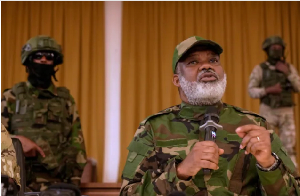The issue of Youth Gun Violence cum armed robbery in our streets both in Ghana and in Canada, especially in the cities of Kumasi, Accra and Toronto continues to raise many questions. For example, are the education systems (in Ghana and Ontario) not inclusive enough? Are Ghanaian youth in Toronto exploiting the social system of the province to their detriment?
Could it be that the children are facing cultural dilemma in their new country of abode? Or, are parents and guardians miserably failing in their duty of providing the needed support to the children? Perhaps, the society is not caring enough! Look at the number of day light armed robberies in the streets of Accra in recent times. What about the rising youth gun violence in the streets of Toronto this summer? Who is to blame?
In whichever direction one points the “accusing fingers” I think the problem of youth gun violence among Ghanaians both in Ghana and elsewhere deserves our attention. The future of our community is seriously threatened by this phenomenon. Therefore, there is the need for this discourse and action to redress the situation.
The Nature of the Problem:
Ms. Jamila Aman, a consultant for Premier Canadian Business Solutions Inc. in Toronto-Canada recently revealed that Toronto Housing is home to 164,000 residents of which more than 65% of black residents are female single mothers which translates into 65% of economic and political powers which are underutilized.
These are opportunities that can be put into good use. She was speaking at a recent African Canadian Youth Leader Roundtable Conference in Toronto. Ms. Aman, a community activist was calling for ACTION!
My personal philosophy as an educator is based on the fact that the greatest aim of education is not knowledge, but action. Though it is good to have knowledge about or in something that knowledge fails to ‘serve’ society if it is not put into action. Action brings results. Results bring improvement and progress for the benefit of the community. Knowledge becomes creative and open when there is action.
Africans have an adage that says, “it takes the whole village (community) to raise up a child.” Undoubtedly, children are our heritage and it is the responsibility of us as adults to identify, talk about and take action on any factors that put our youth “at risk”. According to the National Crime Prevention Council of Canada (1997), “risk are the things or experiences in a young person’s life that increase the chances of a youth being victimized or of developing one or more behavior problems which might be harmful to the youth or/and other persons or property.”
Could it be argued that the society puts the youth at risk. I am tempted to agree with Jean Jacques Rousseau in his assertion that “society has enfeebled man, not merely by robbing him of his own strength, but still more by making his strength insufficient for his needs” (see Classics of Western Thought, Volume III edited by Edger E. Knoebel, 1988, p. 149).
I could not agree with Rousseau the more when I consider risk antecedents such as poverty, neighborhood and family dysfunction that increase the individual’s vulnerability to future behavior problems in the family, school, or community. These environmental risk factors are obviously the products of society. The society must be ‘healed’ of these ‘diseases’ as a means to rescuing our ‘youth at risk’.
There are many groups of “youth at risk”. Among these is the marginalized group of street youth.
Types of Street Youth:
Three categories of street youth are identified. They are the voluntary, homeless and the mentally ill.
1. The voluntary group supposedly comprises of children who have chosen to be on the street as a way of life. Unfortunately, the police, schools and most social work agencies in Ghana have viewed all street children in the country as belonging to this category.
Their policies and practices toward the street children have therefore often worsened the life situation of the street child in Ghana. More disturbing is the position the community has adopted toward street children in Ghana. People hold the voluntaristic explanation that this population of the “youth at risk” are on the street largely by choice. The street children are regarded as good-for-nothing kids in the community. They are called derogating names like kuboro and asan in Ghanaian language.
Perhaps, Ghana is not alone in such voluntaristic reasoning. This reasoning has considerable currency within the political arena of even developed economies such as Canada and USA. Snow and Anderson (1993) quote the American President, Ronald Reagan as having consented to this reasoning when commenting on the problem of homeless people in America in 1984. He said, “one problem we’ve had is the people who are sleeping on grates, the homeless who are homeless by choice.” This notion has not changed much over the years in America and unfortunately in Ghana too, where economic problems facing poor families continue to drive Ghanaian youth onto the street.
Even though it is generally believed that street youth are on the street largely by choice, findings of recent research I conducted on the phenomenon of street children in both Canada and Ghana did not confirm that opinion. As matter of fact, if there are any street children who belong to this category, they would not constitute more than one percent (1%) of population of youth roaming the streets. I discovered “peer attraction” as one of the factors that keep some youth on the streets. Street children often clashed with the law by following their street friends who engaged in “shop-lifting” to survive on the streets.
2. About ninety-five percent (95%) of street youth come under the category of homeless. In Ghana, many street youth between the ages of 12 and 20 are without homes to turn in during the night.
They sleep in front of stores and in abandoned motor vehicles. These youth have traveled from the countryside mainly to fend for themselves in the cities and urban towns due to lack of family support. Poverty or economic dislocation has driven them from their homes. Unfortunately, some single mothers have even encouraged their teen daughters to go to the streets to make ends meet.
Such vulnerable young girls have landed in prostitution and have become homeless, hanging around with pimps whose help is just of exploitation of the children.
Male street children often engage in street trading. Other constitute cheap labor for market women who hire these children to cart their goods to and from the marketplaces. There is among this group a handful of school dropouts.
3. The remaining four percent (4%) of children roaming the street are mentally ill outpatients. Cut off of funds to Ghana’s asylums at Pantang and Ankaful have led to the inability of these institutions for the mentally ill to cope with increasing number of cases that come to them. Unfortunately, some youth are among these numbers though not alarming for this population of “at risk”.
Pathways to the Street:
The ever increasing numbers of homeless street youth in the cities of both Canada and Ghana pose a big question that ought to be considered carefully by those who bring intervention programs to this population of “at risk”. Where have they come from, and why?
My personal experiences with street youth in Ghana and, the recent brief study I embarked on to discover more about street youth in Toronto have convinced me that the roots of homelessness could be traced to structured factors.
“Structural factors”, according to Snow and Anderson (1993) “refers to social arrangements and trends that affect the probability that specific events or life trajectories will be experienced.” They go on further to mention the two sets of structural factors which are often referred to in most discussions of a root of homelessness: One set concerns the scope and sources of residential dislocation, the other concerns the nature and sources of economic dislocation.
As much as I agree with the assertion that residential dislocation is one of the main causes of homelessness in general, I would contend that it could not be considered on the same degree for homeless street youth. Many street youths have found “safety” in the streets not because they have no houses or homes to return to.
Instead, they have either suffered abuse by adults in the homes or suffered lack of family support. The former is true in most cases of street youth in Canada while the latter is equally true for majority of street children in Ghana.
The embattled argument that some youth have chosen to go against their parents’ advice and live in the streets is not sufficient to negate that factor that society/governments and many parents/adults are mostly to blame for pushing our youth onto the streets. We as adults/policy makers/community leaders and politicians have not paid the required attention to the socio-economic needs of challenging/struggling neighborhoods in our constituencies. Thus, allowing poor neighborhoods to breed street youth who terrorize our communities with gun violence and armed robbery.
Suggestion:
One could argue that Africans being the latest immigrants to Canada are facing the problem of adjustment. The raising of the African Youth in the apparent emergence of two (2) cultures has become an issue of major concern to the whole African community in Canada, especially in the city of Toronto.
However, it is also an undeniable fact that many African/Ghanaian families in Canada are breaking down and children are being compelled to fight and struggle for their own survival. Family violence and divorce are on the increase among Ghanaian-Canadians. Emotional and “physical” abuse of children and spouses as well as neglect of children (especially, their educational needs) are becoming chronic problems in the community.
I repeat what I suggested some time ago on this forum that as parents we need to put our knowledge in child upbringing into action to save our kids from waywardness. The home could be likened to a greenhouse where children grow to their fullest potential under the care of wise and patient gardener.
We are like the gardener who nurturers each plant in the greenhouse to come to flower as the Creator has endowed it. “Train up a child in the way he should go....” Proverbs 22:6.
Also, it is unfortunate that there is very little or on support from the community to individuals, families and our youth. Though some Ghanaian community churches are trying to meet such needs in organizing family and youth programs/seminars their efforts are not enough.
All churches and cultural associations must pay the needed attention to supporting our youth. It could be argued in some circles that our youth exploit the laws of Canada to their own detriment (e.g. leaving home early to depend on government welfare; lying about their parents to government authorities; and dropping out of school due to non-inclusive education system in Canada) and find themselves roaming the street eventually, most youth are pushed onto the street by the negligence of their parents and the community at large.
I, therefore, support the initiatives of the present leadership of the Ghanaian Canadian Association of Ontario (GCAO) based in Toronto to bring social, education, health and cultural intervention programs to the Ghanaian youth population in Canada. Their untiring efforts to secure the much anticipated Ghanaian Canadian Heritage Centre in Toronto as a hub to serve the needs of the youth as well as seniors and newcomers to the community. Under the slogan, ONE VOICE, ONE COMMUNITY CENTRE, THE TIME IS NOW! The GCAO spearheaded by President Emmanuel Duodu opines, “Once in a generation, history is made and this is the dawn of that journey!”
Torontonians are invited to be part of this history as the join hands with the GCAO to fundraise on August 12, 2018 for the Ghanaian Canadian Heritage Centre in Toronto. The Time is Now!
Youth gun violence, poverty, fewer opportunities for people of African descent, and black youth facing racism are working against the progress of many African communities in the Western World.
The only hope, according to Ms. Aman of African Canadian Social Development Council, is a new vision to deal with the current crises. We must stop being a consumer society and begin to think as investor society, create activities that unite us instead of just talking about it and lastly snap pot of self-sabotage and focus on education, business and community to become resilient communities to lead our youth to achieve success in their diverse fields of endeavour.
Let us remind ourselves that we can’t take our youth past where we are. We must, therefore, be good examples in both words and deed to our children.
Opinions of Wednesday, 1 August 2018
Columnist: Joe Kingsley Eyiah



















